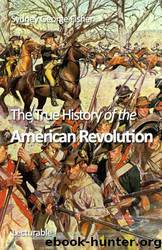The True History of the American Revolution by Sydney George Fisher

Author:Sydney George Fisher [Fisher, Sydney George]
Language: eng
Format: epub
Tags: History
Publisher: Lecturable
Published: 1902-03-15T05:00:00+00:00
MAP OF THE SIEGE OF BOSTON, SHOWING THE IMPORTANCE OF BREED’S HILL, DORCHESTER HEIGHTS, AND NOOK’S HILL
How shall I describe the people who held this opinion ? Some of them were living within sight of the rebel farmers and looking at them from their windows, and the rest were scattered through the colonies to the swamps and pines of Georgia,
No census was taken, and there is no collection of statistics by which we can learn the relative numbers of loyalists and patriots. It is all estimating and guessing; and in this respect the men who took part in the Revolution were not much better off than we are.
The loyalists themselves always believed that they were a majority. Their upholders have supported this assertion by showing that over twenty-five thousand of them enlisted in the British army, and that, without counting those in the privateers and navy, there were in 1779 and at several other times more of them in the British army than there were soldiers in the rebel armies of the Congress. 3 Washington never had twenty-five thousand men under his command, and sometimes only four thousand. If the British generals, the loyalists said, had given suitable encouragement, there would have been still larger loyalist enlistments.
When we examine -the estimates which were made of their numbers by their contemporaries, we find the most extraordinary disagreement. John Adams, writing in 1780, estimated them at not more than a twentieth part of the whole population. In 1815 he estimated them at a little more than a third. Galloway, in his examination before Parliament, and in one of his pamphlets, estimated them at nine-tenths and at four-fifths. General Robertson, in his testimony before the committee on the conduct of the war, estimated them at two-thirds. He described the population as one-third for the Congress, one-third neutral, and one-third loyal, which he thought gave two-thirds which could be called loyal.
I can suggest only one way of reconciling these statements, and that is by defining what is meant by the term loyalist. There were, in a general way, four classes of persons to whom the name could be applied. The first class was composed of people who were thoroughly English, untouched by the American environment and aggressiveness, and not only uninfluenced by the rights of man and Whig principles, but loathing and detesting anything of that kind. Most of these people finally left the country and went to live in England, Canada, or the West Indies. Governor Hutchinson, of Massachusetts, and that very muscular Christian, Rev. Dr. Boucher, of Maryland, were of this class; and perhaps Jonathan Sewall and Daniel Leonard might be included in it.
The second class were somewhat more Americanized. They were anxious to remain; but they wished the country to be ruled by England. They had no confidence in any other rule. They were willing to argue and struggle in a “ legal and constitutional manner,” as they called it, for greater privileges, or for "redress of grievances;” but if England decided against them that would end the matter.
Download
This site does not store any files on its server. We only index and link to content provided by other sites. Please contact the content providers to delete copyright contents if any and email us, we'll remove relevant links or contents immediately.
| Africa | Americas |
| Arctic & Antarctica | Asia |
| Australia & Oceania | Europe |
| Middle East | Russia |
| United States | World |
| Ancient Civilizations | Military |
| Historical Study & Educational Resources |
Washington by Ron Chernow(739)
Patriot Pirates by Robert H. Patton(664)
James Madison: A Life Reconsidered by Lynne Cheney(657)
American Tempest by Harlow Giles Unger(654)
John Adams by David McCullough(609)
The Radicalism of the American Revolution by Gordon S. Wood(608)
Mary Ball Washington by Craig Shirley(577)
George Washington's Secret Six by Brian Kilmeade(574)
The Whites of Their Eyes by Jill Lepore(529)
A Wilderness So Immense by Jon Kukla(510)
American Revolution For Dummies by Steve Wiegand(506)
To Begin the World Over Again by Matthew Lockwood(499)
The American Revolution: A History by Gordon S. Wood(493)
Revolutionary Summer: The Birth of American Independence by Joseph J. Ellis(487)
Poor Richard's Almanack by Benjamin Franklin(485)
Henry Knox: Visionary General of the American Revolution by Mark Puls(479)
The Federalist papers by Alexander Hamilton; James Madison; John Jay; Lawrence Goldman(461)
The First Conspiracy: The Secret Plot to Kill George Washington by Brad Meltzer & Josh Mensch(453)
Independence by John Ferling(440)
